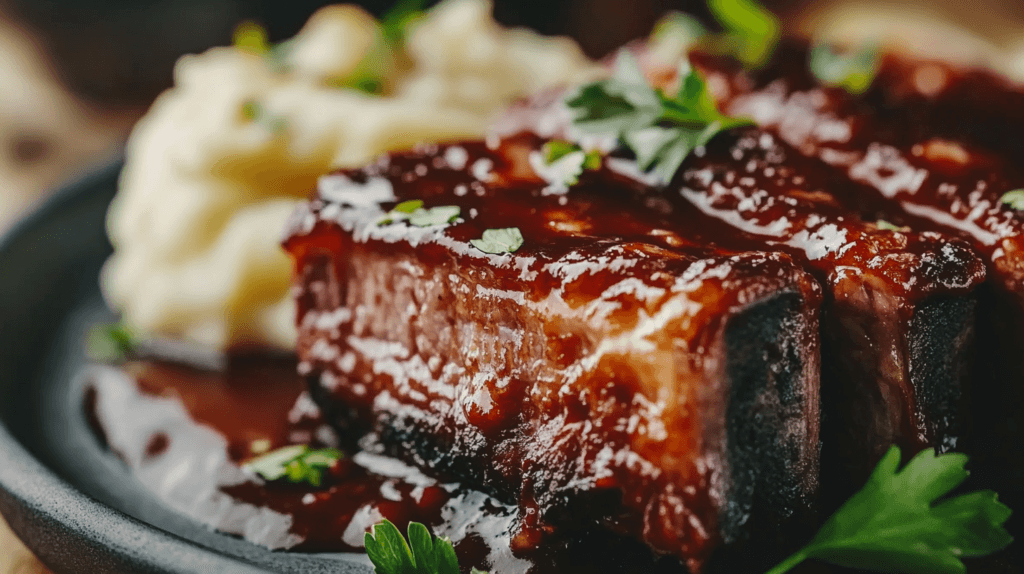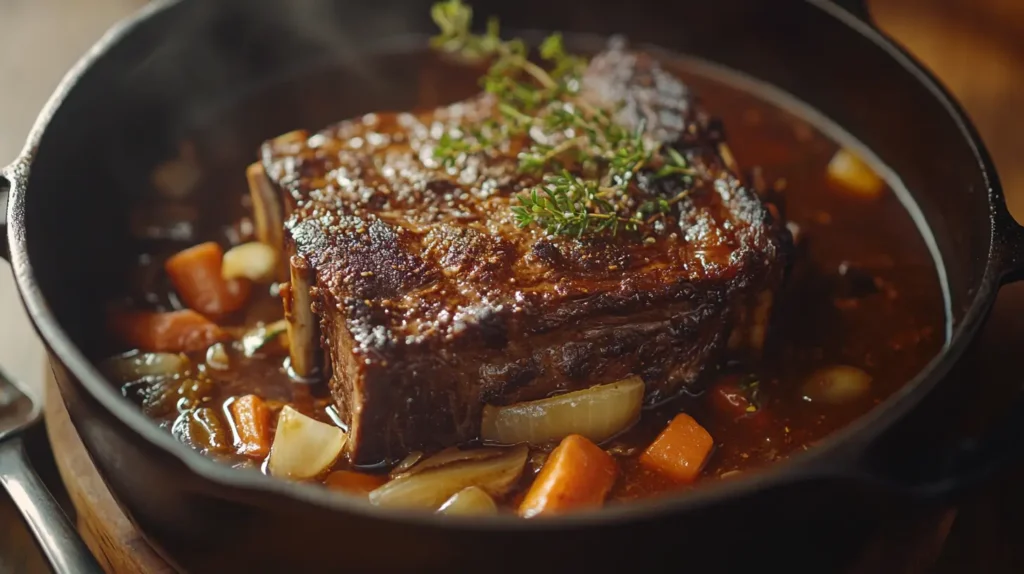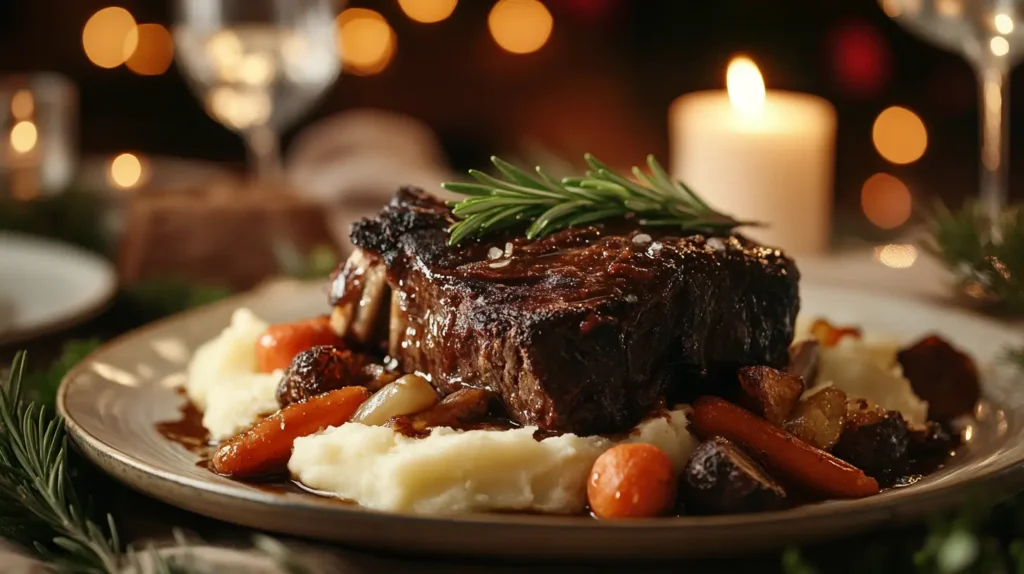Tender beef short ribs are prized for their rich flavor, marbling, and incredible tenderness when cooked properly. They come from the lower rib section of the cow, typically from the chuck or plate primal cuts. These ribs are shorter than traditional back ribs and contain a combination of meat, fat, and connective tissue, which contribute to their deep beefy taste and luxurious mouthfeel

However, despite their potential for succulence, Tender Beef Short Ribst ribs present certain texture challenges. Due to their high content of collagen and connective tissue, they can be tough and chewy if not cooked correctly. Achieving the ideal texture—where the meat is tender, juicy, and easily pulls away from the bone—requires slow and controlled cooking methods. Improper preparation, such as quick cooking at high heat, can result in a dry, rubbery, or overly firm texture.
To overcome these challenges, techniques such as braising, slow-roasting, or smoking at low temperatures are commonly used. These methods allow the collagen to break down into gelatin, transforming the meat into a fork-tender delicacy. Understanding the composition and cooking science behind Tender Beef Short Ribs is essential for ensuring a delicious and satisfying final dish.
Table of Contents
Understanding Why Short Ribs Can Be Tough
The Nature of Short Rib Meat
Tender Beef Short Ribs are a flavorful and well-marbled cut, but their texture can vary significantly depending on how they are cooked. These ribs come from the lower section of the cow’s ribcage, typically from the chuck (shoulder) or plate (belly) regions. Unlike leaner cuts, short ribs contain a good amount of fat, muscle fibers, and connective tissue, all of which contribute to their rich taste but can also make them tough if not handled properly. The muscle fibers in short ribs are relatively coarse and require careful cooking to break them down into a tender and juicy texture.
Why Short Ribs Have a Lot of Connective Tissue
The primary reason short ribs can be tough is their high content of connective tissue, particularly collagen. This is because short ribs come from an area of the cow that is heavily used for movement and support. Muscles that get a lot of exercise develop more connective tissue, which provides structure and strength but can also make the meat chewy and firm when cooked improperly. The collagen in connective tissue needs to be slowly broken down into gelatin, a process that only occurs at low temperatures over a long period. If short ribs are cooked too quickly, the collagen remains tough, making the meat difficult to chew.
How Cooking Methods Impact Tenderness
The key to making short ribs tender lies in the cooking method. Since the meat contains significant amounts of fat and connective tissue, slow and moist cooking techniques are most effective. Methods such as braising, slow roasting, sous vide, and smoking allow enough time for the collagen to convert into gelatin, which gives the meat a soft, melt-in-your-mouth texture.
- Braising (low and slow cooking in liquid) helps dissolve connective tissue while keeping the meat moist.
- Slow roasting at low temperatures allows the fat to render gradually, enhancing tenderness.
- Sous vide cooking precisely controls temperature over an extended period, ensuring optimal collagen breakdown without overcooking.
- Smoking at low temperatures not only tenderizes the meat but also enhances its flavor with a rich, smoky depth.
On the other hand, high-heat and fast-cooking methods like grilling or pan-searing alone are not ideal for short ribs unless they have been pre-cooked using a slow method to tenderize them first. Without this, the meat will likely be tough, dry, and chewy.
Best Cooking Methods to Make Beef Short Ribs Tender
Because Tender Beef Short Ribs contain a lot of connective tissue and muscle fibers, they require slow, gentle cooking to break down collagen and achieve a tender, juicy texture. Several cooking methods excel at this, each offering unique benefits in terms of flavor, texture, and time efficiency.

Low and Slow Cooking Techniques
The best way to ensure tender short ribs is to cook them at a low temperature over a long period. This allows the collagen to gradually convert into gelatin, making the meat moist and flavorful. Low and slow methods such as braising, smoking, slow roasting, and sous vide cooking work exceptionally well for this cut. These techniques also allow the fat to render properly, further enhancing tenderness.
- Ideal temperature range: 200°F–275°F (93°C–135°C)
- Typical cooking time: 3–12 hours, depending on the method
Braising for Maximum Tenderness
Braising is one of the most effective ways to cook short ribs. This method involves searing the meat to develop flavor, then slow-cooking it in a flavorful liquid (such as broth, wine, or a sauce) at a low temperature. The moisture helps break down the collagen while keeping the meat from drying out.
How to braise short ribs:
- Sear the ribs in a hot pan to develop a rich, caramelized crust.
- Sauté aromatics (onions, garlic, carrots, etc.) in the same pan.
- Deglaze with wine or broth, scraping up flavorful bits.
- Slow-cook in the oven at 275°F (135°C) for 3–4 hours or until fork-tender.
Why it works: The combination of moist heat and time allows the collagen to break down fully, creating incredibly soft and flavorful meat.
Smoking Beef Short Ribs
Smoking is a great way to add deep, complex flavors to short ribs while slowly rendering the fat and connective tissue. This method requires patience but rewards you with incredibly tender, smoky, and juicy meat.
How to smoke short ribs:
- Season generously with a dry rub (salt, pepper, garlic powder, and other spices).
- Smoke at 225°F–250°F (107°C–121°C) for 5–8 hours.
- Use hardwoods like oak, hickory, or mesquite for a rich smoky flavor.
- Wrap in butcher paper or foil after 4–5 hours to prevent drying out.
- Rest the meat for 30 minutes before serving.
Why it works: The long exposure to low heat and smoke tenderizes the meat while infusing it with incredible flavor.
Using Sous Vide for Precision Cooking
Sous vide cooking is a modern technique that offers precise temperature control, ensuring perfectly tender short ribs without overcooking. This method involves sealing the ribs in a vacuum bag and cooking them in a water bath at a controlled temperature for an extended period.
How to cook short ribs sous vide:
- Season and vacuum-seal the ribs with herbs and spices.
- Set water temperature to 131°F–165°F (55°C–74°C) depending on desired tenderness.
- 131°F (55°C) for 72 hours → Medium-rare, steak-like texture
- 165°F (74°C) for 24 hours → Braised, fall-apart tenderness
- Sear the ribs in a hot pan or grill after sous vide to create a flavorful crust.
Why it works: Sous vide ensures even cooking, prevents moisture loss, and delivers restaurant-quality tenderness every time.
Pressure Cooking for Faster Results
For those who want tender short ribs without the long wait, a pressure cooker (such as an Instant Pot) is a great option. It speeds up the cooking process by using high-pressure steam to break down the connective tissue in a fraction of the time.
How to cook short ribs in a pressure cooker:
- Sear the ribs in the pressure cooker using the sauté function.
- Add aromatics and liquid (broth, wine, or sauce).
- Cook at high pressure for 45–60 minutes, then let the pressure release naturally.
- Reduce the sauce after cooking for a rich, concentrated flavor.
Why it works: The high-pressure environment dramatically speeds up collagen breakdown, producing fork-tender short ribs in about an hour.
Essential Cooking Tips to Prevent Tough Short Ribs
Cooking tender beef short ribs requires patience, the right techniques, and attention to detail. Even with the best cooking methods, small mistakes can lead to tough, dry, or overcooked meat. To ensure your short ribs turn out perfectly tender and flavorful, follow these essential cooking tips.
Ideal Cooking Times and Temperatures
Since Tender Beef Short Ribs contain a lot of connective tissue, they must be cooked at low temperatures for an extended period to achieve tenderness. The right time and temperature vary depending on the cooking method:
- Braising: 275°F (135°C) for 3–4 hours
- Smoking: 225°F–250°F (107°C–121°C) for 5–8 hours
- Sous Vide:
- 131°F (55°C) for 72 hours (medium-rare, steak-like texture)
- 165°F (74°C) for 24 hours (fall-apart tenderness)
- Pressure Cooking: High pressure for 45–60 minutes, followed by natural release
If short ribs are cooked at too high a temperature for too short a time, the collagen won’t fully break down, resulting in tough meat. Low and slow cooking ensures tender beef short ribs every time.
Importance of Resting Time After Cooking
Just like steaks and roasts, short ribs benefit from resting after cooking. Resting allows the juices to redistribute throughout the meat, preventing dryness and ensuring a more flavorful bite.
- Rest smoked or roasted short ribs for at least 30 minutes before slicing.
- Braised and pressure-cooked short ribs can rest in their cooking liquid to retain moisture.
- Sous vide short ribs should rest briefly before searing to prevent moisture loss.
Skipping the resting step can cause juices to escape, leaving the meat less tender and flavorful.
Using a Meat Thermometer for Accuracy
While cooking times provide a general guideline, the best way to ensure tender beef short ribs is to use a meat thermometer. The internal temperature indicates when the connective tissue has fully broken down:
- Braising and slow roasting: Aim for 195°F–205°F (90°C–96°C) for fall-apart tenderness.
- Smoked short ribs: Should reach 200°F–205°F (93°C–96°C) before resting.
- Sous vide: The set water temperature determines doneness, so a thermometer is not necessary until post-sear.
A thermometer eliminates guesswork and prevents undercooking or overcooking, both of which can result in tough short ribs.
Keeping Short Ribs Moist During Cooking
Moisture retention is crucial for tender beef short ribs, as long cooking times can cause meat to dry out if not handled properly. Here’s how to keep them juicy:
- For braising: Use enough liquid (broth, wine, or sauce) to partially submerge the ribs. Cover the pot tightly to trap moisture.
- For smoking: Spritz the ribs with broth or apple juice every hour and wrap them in butcher paper or foil after 4–5 hours to prevent excessive moisture loss.
- For sous vide: The vacuum-sealed bag naturally locks in juices, ensuring maximum tenderness.
- For pressure cooking: Cook the ribs in a flavorful liquid and let them rest in the cooking juices before serving.
Common Mistakes That Lead to Tough Short Ribs
Cooking tender beef short ribs requires the right technique, and even small mistakes can result in tough, chewy meat. To ensure your short ribs turn out perfectly soft and flavorful, avoid these common cooking errors.
Cooking at Too High of a Temperature
One of the biggest mistakes when preparing short ribs is using high heat to speed up the cooking process. Because short ribs contain a lot of connective tissue, they need low and slow cooking to break down properly. Cooking at temperatures above 300°F (150°C) for an extended period can cause the collagen to seize up rather than slowly melt into gelatin, leading to tough, dry meat. Whether braising, smoking, or roasting, keeping the temperature between 200°F–275°F (93°C–135°C) ensures that the ribs stay juicy and tender.
Not Cooking Long Enough
Even at the right temperature, tender beef short ribs need sufficient time to fully break down their tough fibers. If short ribs are removed from the heat too early, the collagen won’t have enough time to convert into gelatin, leaving the meat chewy. As a general rule:
- Braised short ribs need 3–4 hours at 275°F (135°C)
- Smoked short ribs take 5–8 hours at 225°F (107°C)
- Sous vide short ribs require 24–72 hours depending on the temperature
- Pressure-cooked short ribs need at least 45–60 minutes under high pressure
Patience is key when making short ribs, as rushing the process will lead to a disappointing texture.
Skipping the Searing Process
Searing is an important step in developing rich flavor in short ribs, yet many people skip it. While searing doesn’t directly impact tenderness, it creates a deep, caramelized crust that enhances the overall taste of the dish. To properly sear short ribs:
- Pat them dry to remove excess moisture.
- Heat a heavy pan or Dutch oven over high heat.
- Sear each side for 2–3 minutes until a golden-brown crust forms.
For tender beef short ribs, searing should always be done before braising, roasting, or pressure cooking to maximize flavor depth.
Using the Wrong Cut of Meat
Not all short ribs are the same, and choosing the wrong cut can affect tenderness. Short ribs come from either the chuck (shoulder) or plate (belly) section, and their quality varies.
- English-cut short ribs (bone-in, thick-cut) are best for slow braising.
- Flanken-style short ribs (thin-cut across the bone) are ideal for grilling or quick cooking.
- Boneless short ribs can be used for braising but may require extra moisture to prevent drying out.
For the most tender beef short ribs, opt for well-marbled, bone-in cuts from the chuck or plate section. Choosing a leaner cut, like back ribs or brisket, may not give the same melt-in-your-mouth results.
Frequently Asked Questions (FAQs)
Cooking tender beef short ribs can seem tricky, especially if you’re new to slow-cooking methods. Here are answers to some of the most common questions to help you achieve perfectly soft and flavorful short ribs.
How Long Should I Cook Beef Short Ribs for Tenderness?
The cooking time depends on the method used, but low and slow is the key to tender beef short ribs.
- Braising: 3–4 hours at 275°F (135°C)
- Smoking: 5–8 hours at 225°F–250°F (107°C–121°C)
- Sous Vide: 24–72 hours at 131°F–165°F (55°C–74°C)
- Pressure Cooking: 45–60 minutes on high pressure
Short ribs need enough time to allow the collagen to break down into gelatin, which gives them a rich, melt-in-your-mouth texture. Cutting the cooking time short will leave them tough and chewy.
Can I Make Short Ribs Tender Without Braising?
Yes! While braising is one of the best ways to achieve tender beef short ribs, other methods can also work:
- Smoking at a low temperature for several hours creates tender, flavorful ribs.
- Sous vide cooking at a precise temperature for an extended period ensures perfect tenderness.
- Slow roasting in a covered pan with some moisture can mimic the braising effect.
- Pressure cooking rapidly breaks down connective tissue, making short ribs fork-tender in a fraction of the time.
Each method relies on low and slow cooking to soften the meat and develop rich flavors.
How Do I Fix Tough Beef Short Ribs?
If your short ribs turn out tough, don’t worry—there’s still hope! The main issue is likely undercooking, meaning the collagen hasn’t fully broken down yet. To fix them:
- Return them to a low-temperature oven or slow cooker and continue cooking until they become tender (usually another 30–60 minutes).
- If they were smoked, wrap them in foil with some broth and cook for another hour at 225°F (107°C).
- For pressure-cooked ribs, add 10–15 more minutes of cooking time to soften the meat further.
Remember, the longer tender beef short ribs cook at a low temperature, the softer they become.
Should I Marinate Short Ribs Before Cooking?
Marinating is not required for tender beef short ribs, but it can enhance flavor—especially for grilled or smoked ribs. If you choose to marinate, use ingredients that help break down muscle fibers, such as:
- Acidic components (vinegar, citrus juice, wine)
- Enzymatic ingredients (pineapple, papaya, soy sauce)
- Oil and aromatics (garlic, herbs, spices)
For best results, marinate for at least 4–12 hours, but avoid overly acidic marinades for long periods, as they can make the meat mushy. If braising or slow cooking, focus more on seasoning rather than marinating, as the long cooking process naturally tenderizes the ribs.

Conclusion
Final Thoughts on Making Beef Short Ribs Tender
Achieving tender beef short ribs requires patience, the right cooking techniques, and proper preparation. Because short ribs contain a lot of connective tissue, they need low and slow cooking to break down the collagen into rich, flavorful gelatin.
Methods like braising, smoking, sous vide, and pressure cooking all work well, as long as the ribs are given enough time to soften.
Avoid common mistakes such as cooking at too high a temperature, not cooking long enough, or skipping the searing process. These errors can result in tough, chewy meat.
By selecting the right cut, maintaining moisture during cooking, and using a meat thermometer for accuracy, you can ensure that your tender beef short ribs turn out perfectly juicy and fall-apart soft every time.
Whether you’re making them for a special occasion or a comforting meal, mastering these techniques will guarantee delicious, restaurant-quality short ribs at home.
